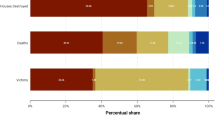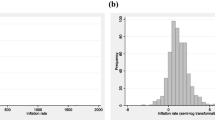Abstract
When full competition prevails in product, labor, and capital markets, positive or negative external trade shocks may be accommodated by the migration of jobs between sectors; the negative impact on some households’ income of lower nominal wages will be more than offset by lower prices of imported final goods. Unemployment, if any, will be temporary, unless labor market rigidities prevent the necessary adjustment. By contrast, we argue that trade shocks trigger a process of creative destruction that necessarily causes distortions in the structure of productive capacity and, hence, market disequilibria. Therefore, the structural change that follows trade shocks can no longer be analyzed within an equilibrium framework. The transition following a shock may be characterized by increasing imbalances, and create scope for policy intervention. The model presented in this paper, which focuses on the time dimension of production and market imbalances, allows us to clarify the debate.











Similar content being viewed by others
Notes
We assume that these export quotas are not related to domestic factors. For example, the penetration of low cost goods from China and other emerging economies is based on cost differentials so wide in size that they reduce the capacity to export of some (basic) sectors regardless of domestic pricing policies.
Upper case variables usually denote economy-wide variables, while lower cases denote firm specific ones.
Notice that an issue of strategic behavior could arise here: knowing the rationing rule, firms could modify their behavior in order to obtain, once rationed, their optimal quantity. We overlook this issue, as it presupposes perfect knowledge by the firm of the behavior of its competitors in their own as well as in the other sector.
Specifically, we have κ b = 1.6, κ a = 0.8, λ b = 0.2, λ a = 10. Overall productivity in the two sectors is then X b /L b = 0.17 and X a /L a = 0.74. As the model that we build is strongly stylized, the parameter values we choose are simply meant to capture qualitative features of the system.
This simulation extends to a disequilibrium framework Keynes’ argument for wage rigidity as a means to avoid cumulative aggregate demand-aggregate supply downward spiraling (see the chapter on wages of Keynes 1936). For a detailed discussion of this argument, refer to Amendola et al. (2004) and Saraceno (2004).
References
Amendola M, J-L Gaffard (1998) Out of equilibrium. Clarendon Press, Oxford
Amendola M, J-L Gaffard, Saraceno F (2004) Wage flexibility and unemployment: the Keynesian perspective revisited. Scott J Polit Econ 51(5):654–674
Benassy J-P (1982) The economics of market disequilibrium. Academic Press, New York
Brecher RA (1974) Minimum wage rates and the pure theory of international trade. Q J Econ 88:98–116
Gomory RE, WJ Baumol (2000) Global trade and conflicting national interests. MIT Press, Cambridge
Hicks JR (1953) An inaugural lecture. Oxf Econ Pap 5:117–35
Hicks JR (1973) Capital and time. Clarendon Press, Oxford
Keynes JM (1936) The general theory of employment, interest and money. Macmillan, London
Krugman PR (1985) A technology gap model of international trade. In: Jungenfelt K, Hague D (eds) Structural adjustment in advanced economies. Macmillan, London
Lucas RE (1993) Making a miracle. Econometrica 61(2):251–72
Rodrik D (1998) The debate over globalization: how to move forward by looking backward. In: Conference on the future of the world trading system. Institute for International Economics, Washington, DC
Samuelson PA (2004) Where Ricardo and Mill rebut and confirm arguments of mainstream economists supporting globalization. J Econ Perspect 18(3):135–146
Saraceno F (2004) Wage regimes, accumulation, and finance constraints: Keynesian unemployment revisited. Document de Travail de l’OFCE, Paris, 2004-1
Stiglitz JE, Charlton A (2006) Fair trade for all. Oxford University Press, Oxford
Acknowledgements
This paper benefited of funding from the European Community’s Seventh Framework Programme (FP7/2007–2013) under Socio-economic Sciences and Humanities, grant agreement no. 225408 (POLHIA). We thank Mario Amendola, Uwe Cantner, and an anonymous referee for comments and suggestions on a previous draft. Our work also benefited from interaction with participants to the workshop on Openness and Innovation in Emerging Financial Markets, Beijing, March 2007, and to the International Economic Association Conference, Istanbul, June 2008. The usual disclaimers apply.
Author information
Authors and Affiliations
Corresponding author
Appendix: Proof of propositions
Appendix: Proof of propositions
Proof of Proposition 1 \(\frac{d\alpha}{dW_{a}}>0\) and \(\frac{d\alpha}{dW_{b}}<0.\)
Proof
\(\frac{d\alpha}{dW_{a}}>0:\)
Substituting:
\(\frac{d\alpha}{dW_{b}}<0:\)
Substituting:
□
Proof of Proposition 2 \(\frac{d\pi_{a}}{dW_{a}}>0\) and \(\frac{d\pi_{a}}{dW_{b}}>0.\)
Proof
Equilibrium profit can be defined, from Eqs. 7 and 8a:
As ξ a and ξ b are positively affected by both W a and W b , we conclude that any increase in external demand increases equilibrium profits. □
Rights and permissions
About this article
Cite this article
Gaffard, JL., Saraceno, F. International trade and domestic distortions. J Evol Econ 22, 275–301 (2012). https://doi.org/10.1007/s00191-011-0244-2
Published:
Issue Date:
DOI: https://doi.org/10.1007/s00191-011-0244-2
Keywords
- Globalization
- Trade
- Financial constraints
- Creative destruction
- Wage flexibility
- Time to build
- Firm migration




